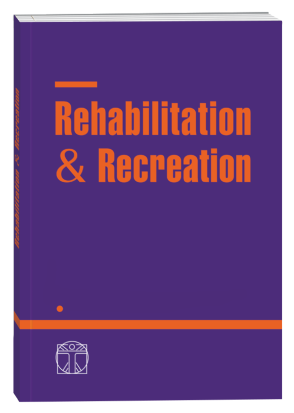THE USE OF INNOVATIVE VIRTUAL REALITY TECHNIQUES IN THE PHYSICAL THERAPY OF PATIENTS WITH MUSCULOSKELETAL INJURIES
DOI:
https://doi.org/10.32782/2522-1795.2023.17.18Keywords:
virtual reality, musculoskeletal diseases, physical rehabilitation.Abstract
Compared to simple conventional care and other treatments, virtual reality has been found to provide significant pain relief, improved functionality, reduced symptoms, and increased joint range of motion in the treatment of chronic musculoskeletal conditions. However, virtual reality treatment of patients with non-chronic pain, such as total knee replacement and ankle sprains, as well as patients who have undergone a very short course of virtual reality, has not shown a significant difference in parameters compared to simple traditional care or other forms of treatment. Objective. To thoroughly analyze and highlight the potential of using innovative virtual reality techniques in physical therapy for patients suffering from musculoskeletal injuries. The specific goal is to study the possibilities, effectiveness and benefits of implementing VR in the rehabilitation process of the target audience. Material and methods. A systematic analysis of modern scientific sources, including scientific articles, books, studies and expert opinions related to the use of innovative virtual reality techniques in physical therapy, was carried out. We assessed the impact of VR on patients with musculoskeletal diseases by analyzing randomized controlled trials (RCTs). The databases used were PubMed, IEEE and MEDLINE. Research results. After conducting a systematic analysis of scientific sources and evaluating the effectiveness of VR techniques in the physical therapy of patients with musculoskeletal injuries, we obtained significant results that demonstrate the powerful potential of VR in rehabilitation practice. This revolutionary change in treatment methods has proven to be not only a technological innovation, but also a significant step in improving the efficiency and quality of the rehabilitation process. It is noted that the effectiveness of VR techniques is confirmed by the available data and research which support excellent results of restoration of patients' functions. It has been determined that approaches that combine game elements with traditional physiotherapy exercises are particularly progressive. Conclusions. Innovative techniques allow creating individualized and motivating programs that help improve motor skills, motor control, and the general physical condition of patients. Virtual reality creates an immersive and engaging environment that helps to forget about pain and stress, and provides a more positive approach to rehabilitation.
References
Попадюх Ю. А. Сучасні комп’ютеризовані комплекси та системи у технологіях фізичної реабілітації : навч. посіб. К. : Центр учбової літератури, 2017. 300 с.
Alfieri F.M., Da Silva Dias C., De Oliveira N.C., Battistella L.R. Gamification in Musculoskeletal Rehabilitation. Curr. Rev. Musculoskelet. Med. 2022. № 15. Р. 629–636.
Blasco J., Igual-Camacho C., Blasco M., Antón-Antón V., Ortiz-Llueca L., Roig-Casasús S. The efficacy of virtual reality tools for total knee replacement rehabilitation: A systematic review. Physiother. Theory Pract. 2021. № 37. Р. 682–692.
Brea-Gómez B., Torres-Sánchez I., Ortiz-Rubio A., Calvache-Mateo A., Cabrera-Martos I., López-López L., Valenza M.C. Virtual Reality in the Treatment of Adults with Chronic Low Back Pain: A Systematic Review and Meta-Analysis of Randomized Clinical Trials. Int. J. Environ. Res. Public Health. 2021. № 18. 11806 р.
Chang Y.J., Chen S.F., Huang J.D. A Kinect-based system for physical rehabilitation: A pilot study for young adults with motor disabilities. Res. Dev. Disabil. 2011. № 32. P. 2566–2570. DOI: 10.1016/j.ridd.2011.07.002.
Dos Santos Mendes F.A., Pompeu J.E., Modenesi Lobo A., Guedes da Silva K., Oliveira T de P., Peterson Zomignani A., Pimentel Piemonte M.E. Motor learning, retention and transfer after virtual-reality-based training in Parkinson’s disease—Effect of motor and cognitive demands of games: A longitudinal, controlled clinical study. Physiotherapy. 2012. № 98. P. 217–223. DOI: 10.1016/j.physio.2012.06.001.
Jin C., Feng Y., Ni Y., Shan Z. Virtual reality intervention in postoperative rehabilitation after total knee arthroplasty: A prospective and randomized controlled clinical trial. Int. J. Clin. Exp. Med. 2018. № 11. Р. 6119–6124.
Kantha P., Lin J.J., Hsu W.L. The Effects of Interactive Virtual Reality in Patients with Chronic Musculoskeletal Disorders: A Systematic Review and Meta-Analysis. Games Health J. 2023. № 12. Р. 1–12.
Levac D., Glegg S., Colquhoun H., Miller P., Noubary F. Virtual Reality and Active Videogame-Based Practice, Learning Needs, and Preferences: A Cross-Canada Survey of Physical Therapists and Occupational Therapists. Games Health J. 2017. № 6. Р. 217–228. DOI: 10.1089/
g4h.2016.0089.
Musculoskeletal health. World Health Organization (WHO). URL: https://www.who.int/news-room/fact-sheets/detail/musculoskeletal-conditions (дата звернення: 22.08.2023).
Thomas J.S., France C.R., Applegate M.E., Leitkam S.T., Walkowski S. Feasibility and Safety of a Virtual Reality Dodgeball Intervention for Chronic Low Back Pain: A Randomized Clinical Trial. J. Pain. 2016. № 17. Р. 1302–1317.
Vogt S., Skjæret-Maroni N., Neuhaus D., Baumeister J. Virtual reality interventions for balance prevention and rehabilitation after musculoskeletal lower limb impairments in young up to middle-aged adults: A comprehensive review on used technology, balance outcome measures and observed effects.
Downloads
Published
How to Cite
Issue
Section
License

This work is licensed under a Creative Commons Attribution-NonCommercial-NoDerivatives 4.0 International License.












